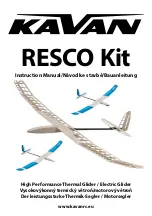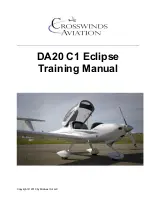
Flying the Stratus 8
Section 5
23
Rapid descent methods
In many flying situations a very rapid
descent is necessary to avoid a dangerous
situation, e.g. the upcurrent from a cumulus
cloud, an approaching cold front or a storm
front.
Rapid descent methods should all be
practised in calm conditions and at sufficient
altitude so that a pilot is then able to employ
them effectively if extreme conditions arise.
The rapid descents are divided into three
different manoeuvres which increase the
sink rate safely and in a controllable
manner.
Spiral dives
The spiral dive is the most effective method
for making a rapid descent, and can allow
sink rates of up to 20 m/s to be reached. It is
suitable where there is a high ascent rate
and little wind.
The certification tests differentiate between
sink rates over and under 14 m/s. The
Stratus 8 automatically recovers from the
spiral dive within one turn up to 14 m/s.
Above 14 m/s, it may be necessary to break
the outside half of the wing and/or weight-
shift to the outside to recover from the
spiral. With a sink rate up to 20 m/s, the
spiral does not tighten automatically. The
certification test flights are carried out with a
carabiner distance (centre to centre) of
42cm.
Starting the manoeuvre
Begin the spiral dive whilst flying at full
speed by flying a turn which becomes
tighter and tighter and by using weight-
shifting to the inside (refer here to “Turns”
also).
The bank angle and sink rate are controlled
by carefully applying or releasing the inside
brake.
Look down before and during the spiral dive
to maintain a constant check on your
distance from the ground.
IMPORTANT
The outer wing tip may collapse during
the spiral dive although this is no cause
for concern. It can be avoided by lightly
braking on the outside. Release the
brakes carefully.
Recovery
Recover from the spiral dive slowly and
steadily over several turns. The inside
brakes are gradually released. If the brakes
are released too quickly, the increased
speed can cause the wing to climb, become
unsettled or partly collapse. Recovery can
be assisted by braking lightly on the outside.
WARNING
In the spiral dive, very high turn speeds
can be reached with an increase in
acceleration due to gravity (up to over
6g), so exercise care when attempting
this manoeuvre. Take note of the
following:
•
Do not continue the spiral dive for
too long: it could cause a loss of
consciousness.
•
Always maintain ground clearance
of 150 – 200m.
•
Spiral dives with “big ears” lead to
extreme loading of the open section
of the canopy. This move is
prohibited in Germany.











































